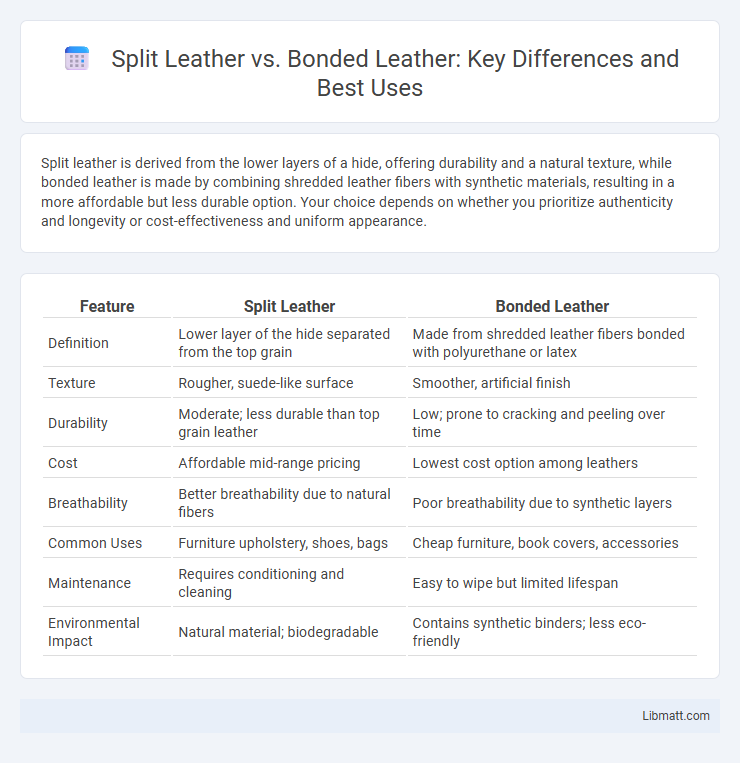Split leather is derived from the lower layers of a hide, offering durability and a natural texture, while bonded leather is made by combining shredded leather fibers with synthetic materials, resulting in a more affordable but less durable option. Your choice depends on whether you prioritize authenticity and longevity or cost-effectiveness and uniform appearance.
Table of Comparison
| Feature | Split Leather | Bonded Leather |
|---|---|---|
| Definition | Lower layer of the hide separated from the top grain | Made from shredded leather fibers bonded with polyurethane or latex |
| Texture | Rougher, suede-like surface | Smoother, artificial finish |
| Durability | Moderate; less durable than top grain leather | Low; prone to cracking and peeling over time |
| Cost | Affordable mid-range pricing | Lowest cost option among leathers |
| Breathability | Better breathability due to natural fibers | Poor breathability due to synthetic layers |
| Common Uses | Furniture upholstery, shoes, bags | Cheap furniture, book covers, accessories |
| Maintenance | Requires conditioning and cleaning | Easy to wipe but limited lifespan |
| Environmental Impact | Natural material; biodegradable | Contains synthetic binders; less eco-friendly |
Overview: Split Leather vs Bonded Leather
Split leather originates from the fibrous part of the animal hide left after the top grain is separated, offering moderate durability and a natural texture ideal for upholstery and accessories. Bonded leather consists of shredded leather fibers bonded with polyurethane and adhesives, providing a cost-effective, uniform appearance but lower durability compared to split leather. Your choice depends on whether you prioritize authenticity and longevity or affordability and consistent look.
Definitions and Key Differences
Split leather originates from the fibrous underside of a hide, offering a more affordable and less durable option compared to full-grain leather, while bonded leather is manufactured by blending leather scraps with polyurethane or latex to create a synthetic-like material. You should consider that split leather maintains more natural texture and breathability, whereas bonded leather often lacks durability and can peel over time due to its composite nature. Key differences include construction methods, longevity, appearance, and price, with split leather providing a balance of cost and quality, whereas bonded leather serves as a budget-friendly but less resilient alternative.
Manufacturing Processes
Split leather is produced by separating the fibrous part of the hide beneath the top grain, which is then sanded and treated to create a suede-like texture, often finished with a protective coating. Bonded leather is manufactured by shredding leftover leather scraps mixed with bonding agents and polyurethane, then pressed into sheets to form a leather-like material. The fundamental difference lies in split leather retaining natural hide layers, whereas bonded leather is a composite product with significantly less genuine leather content.
Appearance and Texture Comparison
Split leather has a natural, grainy texture that closely resembles full-grain leather, offering a more authentic and high-quality appearance. Bonded leather features a smoother, uniform surface created by blending leather scraps with polyurethane, resulting in a less natural look with a synthetic feel. The texture of split leather is generally more breathable and flexible, whereas bonded leather tends to be stiffer and less durable over time.
Durability and Lifespan
Split leather offers superior durability and a longer lifespan compared to bonded leather, as it is made from the fibrous part of the hide and maintains much of the original leather's strength. Bonded leather consists of shredded leather fibers mixed with polyurethane or latex, making it less resistant to wear and prone to peeling over time. For your furniture or accessories, choosing split leather ensures greater longevity and better performance under daily use.
Cost and Affordability
Split leather is generally more affordable than full-grain leather but costs more than bonded leather due to its durability and quality. Bonded leather is the most budget-friendly option, made from leather scraps bonded together, which sacrifices longevity for cost savings. Your choice depends on balancing budget with desired durability and appearance.
Common Uses and Applications
Split leather is frequently used in furniture upholstery, automotive interiors, and fashion accessories due to its durability and cost-effectiveness. Bonded leather is commonly found in budget-friendly furniture, bookbinding, and decorative items where aesthetic appeal is desired but longevity is less critical. Both materials serve distinct roles in manufacturing, with split leather favored for higher quality products and bonded leather for economical and visually appealing alternatives.
Maintenance and Care Tips
Split leather requires regular conditioning with leather-specific oils to prevent drying and cracking, while bonded leather benefits from gentle cleaning with a damp cloth and mild soap to avoid damage to its synthetic fibers. You should avoid exposing both types to direct sunlight and heat sources, which can cause fading and deterioration over time. Proper maintenance ensures longevity, keeping split leather supple and bonded leather intact for everyday use.
Environmental Impact
Split leather, derived from the lower layers of animal hides, generally has a lesser environmental impact than bonded leather, which is made from shredded leather scraps mixed with synthetic adhesives. Bonded leather production involves additional chemical processing and synthetic materials, increasing its carbon footprint and potential for pollution. Choosing products made from split leather can reduce your environmental impact by supporting less chemically intensive manufacturing processes.
Choosing the Right Leather for Your Needs
Split leather offers durability and a natural texture, making it suitable for furniture and apparel where strength and appearance are priorities. Bonded leather, composed of leather scraps bonded with polyurethane, provides an affordable option for decorative items but lacks the longevity of genuine leather. Selecting between split and bonded leather depends on balancing budget constraints with desired durability and aesthetic quality.
Split leather vs bonded leather Infographic

 libmatt.com
libmatt.com